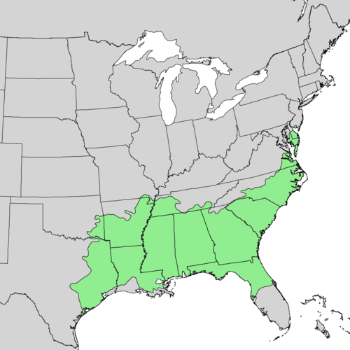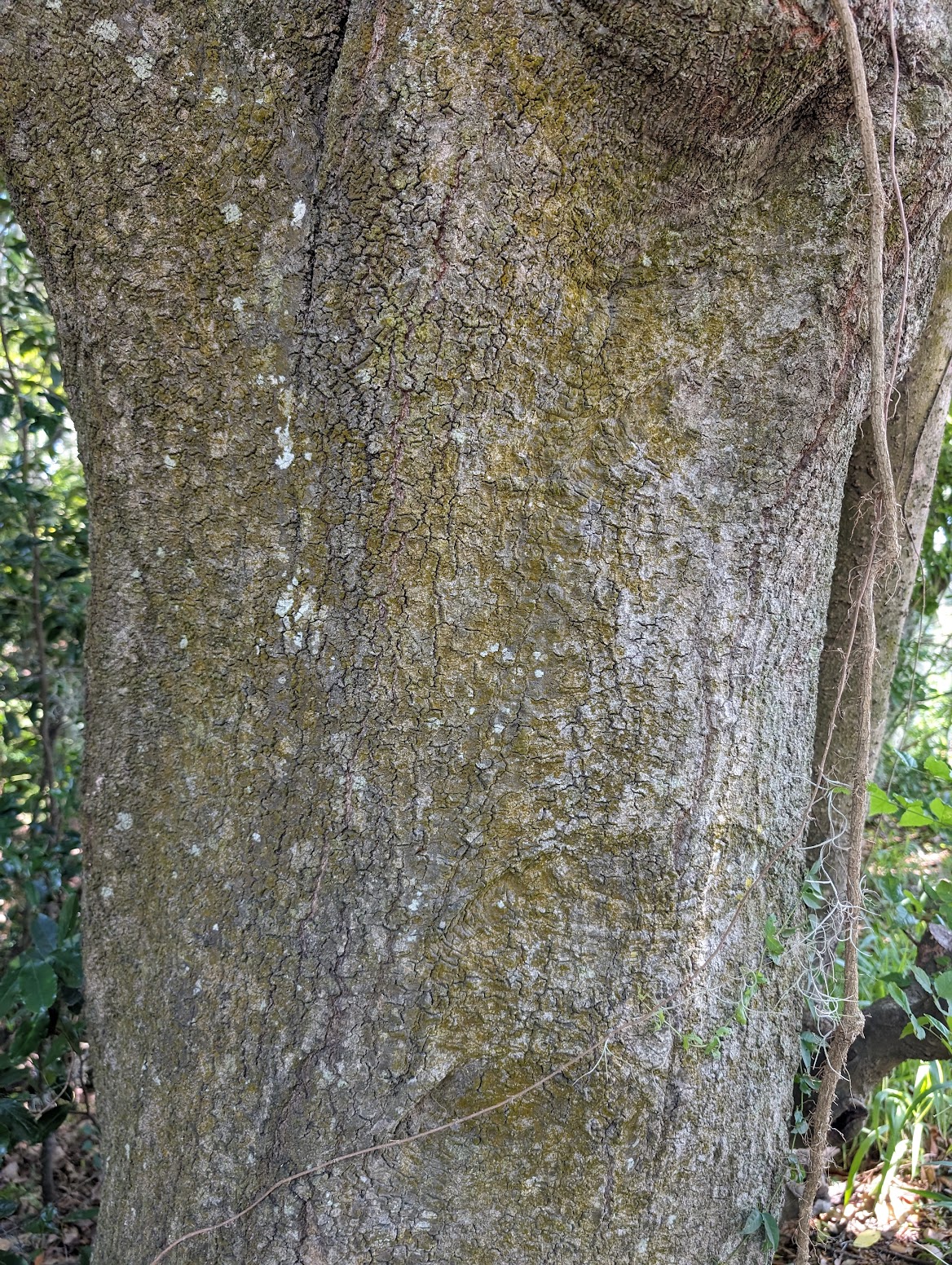Fagaceae – Beech Family
In 2024, this water oak measured 55.2 feet tall and had a diameter of 26 inches. Based on USDA Forest Service models, it will absorb approximately 3,394 lbs. of carbon over the next 20 years. Put simply, this tree alone will offset up to 13,736 car miles worth of carbon dioxide.
See all species on our Campus Tree Tour.
Introduction
The water oak is a medium-sized red oak native to the Southeastern United States. As the name suggests, this tree species is often found near sources of water including running streams, placid lakes, or soggy soils. The water oak has value as a timber species, and its acorns can be used to thicken stews, make bread, and feed wildlife.
Physical Description
Life expectancy: Up to 50 years
Height: 50 – 60 feet
Crown: 60 – 70 feet
Diameter: 20 – 28 inches
Bark: Greyish brown. Shallow and not deeply fissured or blocky.
Leaves: Deciduous, simple, and alternately arranged upon the twig. Leaf shape is variable but leaves commonly have a broad tip and narrow base which gives it a spatulate shape (like a spatula).
The upper surface is dark green and shiny while underneath is paler green with clumps of pubescence (hairs) where leaf veins split from the midrib (called axillary hairs).
Twigs: Has a cluster of buds at the terminal end of the twig, a distinguishing characteristic of oaks.
Flowers: Yellow-green catkins (male flowers) and small spike flowers (female) are produced in the spring.
Fruits: Small (1/2 inch) brown acorns with a flat cap that covers 1/3rd of the nut. Matures in the fall.
Key Identification Characteristics: bark, spatulate leaves, leaves with axillary hairs, terminal buds
Past and Present Uses
Water oak acorns were used by indigenous tribes to thicken stews or ground into flour to make bread. The trees are also used to restore bottomland hardwood forests that were once cleared for agriculture and plantations.
The water oak has commercial value for timber, fuel, veneer, and plywood. Often, these trees can lose their lumber quality due to epicormic growth, which is new growth sprouting from the trunk in response to stress. This creates knots and decreases the wood’s clarity. The water oak can be planted for its shade, yet its shorter life span and susceptibility to decay makes it an uncommon urban species.
Ecological Importance
Origin: Native to the United States
Native Range: Found in the Southeastern United States along the Coastal Plain from New Jersey south to Florida, west to Texas, and north to the Mississippi Valley.

Figure 1. Native range of Water Oak. Photo credit: U.S. Geological Survey
The water oak is found on a wide range of soils from wet bottomlands to dry, well-drained uplands. It grows best in rich, moist soils and floodplain sites along rivers and streams; however, it can grow on flatwoods and sandhills when fire is absent. The water oak is often associated with other bottomland species such as swamp chestnut oak, American beech, sweetgum, American Elm, ash, and spruce pine.
The water oak acorns serve as a food source for small mammals and birds despite its high tannin content which makes it less palatable than other acorns. Deer consume the leaves while the trunk cavities offer nesting sites for southern flying squirrels, red-bellied woodpeckers, and great crested flycatchers. Insects also consume the leaves, and various moths and butterflies use the tree as a host plant for their larvae. Additionally, gall wasp will form galls, or small growths on the twigs, to raise their larvae.
More Information
https://edis.ifas.ufl.edu/publication/ST553
References
Carey, J. H. (1992). Quercus nigra. In: Fire Effects Information System, [Online]. U.S. Department of Agriculture, Forest Service, Rocky Mountain Research Station, Fire Sciences Laboratory. https://www.fs.usda.gov/database/feis/plants/tree/quenig/all.html
Gilman, E. F., Watson, D. G., Klein, R. W., Koeser, A. K., Hilbert, D. R., & McLean, D. C. (2019). Enh-711/ST553: Quercus nigra: Water oak. Ask IFAS - Powered by EDIS. https://edis.ifas.ufl.edu/publication/ST553
i-Tree. (2006). Tree tools - calculate the benefits of trees!. i-Tree. https://www.itreetools.org/
Lady Bird Johnson Wildflower Center - The University of Texas at Austin. (n.d.). Quercus nigra. Plant Database. https://www.wildflower.org/plants/result.php?id_plant=quni
North Carolina Extension. (n.d.). Quercus nigra. North Carolina Extension Gardener Plant Toolbox. https://plants.ces.ncsu.edu/plants/quercus-nigra/
Vozzo, J. A. (n.d.). Water Oak. Quercus nigra L. https://www.srs.fs.usda.gov/pubs/misc/ag_654/volume_2/quercus/nigra.htm#:~:text=Water%20oak%20(Quercus%20nigra)%2C,second%20growth%20on%20cutover%20lands



